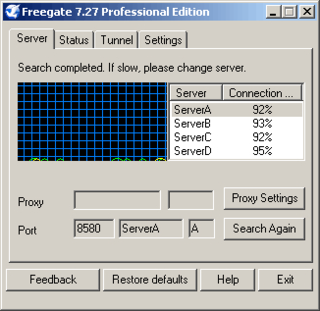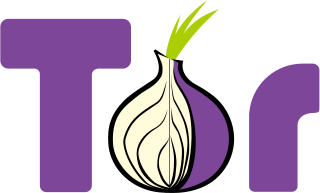
In computer networking, a proxy server is a server application that acts as an intermediary between a client requesting a resource and the server providing that resource. It improves privacy, security, and performance in the process.
China censors both the publishing and viewing of online material. Many controversial events are censored from news coverage, preventing many Chinese citizens from knowing about the actions of their government, and severely restricting freedom of the press. China's censorship includes the complete blockage of various websites, apps, video games, inspiring the policy's nickname, the "Great Firewall of China", which blocks websites. Methods used to block websites and pages include DNS spoofing, blocking access to IP addresses, analyzing and filtering URLs, packet inspection, and resetting connections.
Deep packet inspection (DPI) is a type of data processing that inspects in detail the data being sent over a computer network, and may take actions such as alerting, blocking, re-routing, or logging it accordingly. Deep packet inspection is often used for baselining application behavior, analyzing network usage, troubleshooting network performance, ensuring that data is in the correct format, checking for malicious code, eavesdropping, and internet censorship, among other purposes. There are multiple headers for IP packets; network equipment only needs to use the first of these for normal operation, but use of the second header is normally considered to be shallow packet inspection despite this definition.
The Great Firewall is the combination of legislative actions and technologies enforced by the People's Republic of China to regulate the Internet domestically. Its role in internet censorship in China is to block access to selected foreign websites and to slow down cross-border internet traffic. The Great Firewall operates by checking transmission control protocol (TCP) packets for keywords or sensitive words. If the keywords or sensitive words appear in the TCP packets, access will be closed. If one link is closed, more links from the same machine will be blocked by the Great Firewall. The effect includes: limiting access to foreign information sources, blocking foreign internet tools and mobile apps, and requiring foreign companies to adapt to domestic regulations.

Psiphon is a free and open-source Internet censorship circumvention tool that uses a combination of secure communication and obfuscation technologies, such as a VPN, SSH, and a Web proxy. Psiphon is a centrally managed and geographically diverse network of thousands of proxy servers, using a performance-oriented, single- and multi-hop routing architecture.

Freegate is a software application developed by Dynamic Internet Technology (DIT) that enables internet users from mainland China, South Korea, North Korea, Syria, Vietnam, Iran, United Arab Emirates, Germany, New Zealand, Australia, and the United Kingdom among others, to view websites blocked by their governments. The program takes advantage of a range of proxy servers called Dynaweb. This allows users to bypass Internet firewalls that block web sites by using DIT's Peer-to-peer (P2P)-like proxy network system. FreeGate's anti-censorship capability is further enhanced by a new, unique encryption and compression algorithm in the versions of 6.33 and above. Dynamic Internet Technology estimates Freegate had 200,000 users in 2004. The maintainer and CEO of DIT is Bill Xia.

Internet censorship is the legal control or suppression of what can be accessed, published, or viewed on the Internet. Censorship is most often applied to specific internet domains but exceptionally may extend to all Internet resources located outside the jurisdiction of the censoring state. Internet censorship may also put restrictions on what information can be made internet accessible. Organizations providing internet access – such as schools and libraries – may choose to preclude access to material that they consider undesirable, offensive, age-inappropriate or even illegal, and regard this as ethical behaviour rather than censorship. Individuals and organizations may engage in self-censorship of material they publish, for moral, religious, or business reasons, to conform to societal norms, political views, due to intimidation, or out of fear of legal or other consequences.
An anonymizer or an anonymous proxy is a tool that attempts to make activity on the Internet untraceable. It is a proxy server computer that acts as an intermediary and privacy shield between a client computer and the rest of the Internet. It accesses the Internet on the user's behalf, protecting personal information of the user by hiding the client computer's identifying information such as IP addresses. Anonymous proxy is the opposite of transparent proxy, which sends user information in the connection request header.

Tor, short for The Onion Router, is free and open-source software for enabling anonymous communication. It directs Internet traffic via a free, worldwide, volunteer overlay network that consists of more than seven thousand relays.
The Golden Shield Project, also named National Public Security Work Informational Project, is the Chinese nationwide network-security fundamental constructional project by the e-government of the People's Republic of China. This project includes a security management information system, a criminal information system, an exit and entry administration information system, a supervisor information system, a traffic management information system, among others.

UltraSurf is a freeware Internet censorship circumvention product created by UltraReach Internet Corporation. The software bypasses Internet censorship and firewalls using an HTTP proxy server, and employs encryption protocols for privacy.
Internet censorship circumvention, also referred to as going over the wall or scientific browsing in China, is the use of various methods and tools to bypass internet censorship.

VPN blocking is a technique used to block the encrypted protocol tunneling communications methods used by virtual private network (VPN) systems. Often used by large organizations such as national governments or corporations, it can act as a tool for computer security or Internet censorship by preventing the use of VPNs to bypass network firewall systems.
Hotspot Shield is a public VPN service operated by AnchorFree, Inc. Hotspot Shield was used to bypass government censorship during the Arab Spring protests in Egypt, Tunisia, and Libya.
uProxy was an extension for Chrome and Firefox, which allowed users to access the Internet via a web proxy. This project has been superseded by Outline VPN. The extension works by enabling a user to share their Internet connection with someone else. Google Ideas provided funding for the development which was carried out by the University of Washington and Brave New Software — the same organization behind the anti-censorship tool Lantern. The extension is intended to allow users to get more secure access to the Internet without being monitored. It is free/libre software under Apache license 2.0. The software has been discontinued, stating on their website " uProxy was an open source project led by the University of Washington and seeded by Jigsaw. Although the project is no longer supported, the code is still available on GitHub."

In internet governance, network sovereignty, also called digital sovereignty or cyber sovereignty, is the effort of a governing entity, such as a state, to create boundaries on a network and then exert a form of control, often in the form of law enforcement over such boundaries.

Domain fronting is a technique for Internet censorship circumvention that uses different domain names in different communication layers of an HTTPS connection to discreetly connect to a different target domain than is discernable to third parties monitoring the requests and connections.

HMA is a VPN service founded in 2005 in the United Kingdom. It has been a subsidiary of the Czech cybersecurity company Avast since 2016.
A virtual private network (VPN) service provides a proxy server to help users bypass Internet censorship such as geoblocking and users who want to protect their communications against data profiling or MitM attacks on hostile networks.

Snowflake is a software package for assisting others in circumventing internet censorship by relaying data requests. Snowflake relay nodes are meant to be created by people in countries where Tor and Snowflake are not blocked. People under censorship then use a Snowflake client, packaged with the Tor Browser or Onion Browser, to access the Tor network, using Snowflake relays as proxy servers. Access to the Tor network can in turn give access to other blocked services. A Snowflake node can be created by either installing a browser extension, installing a stand-alone program, or browsing a webpage with an embedded Snowflake relay. The node runs whenever the browser or program is connected to the internet.











